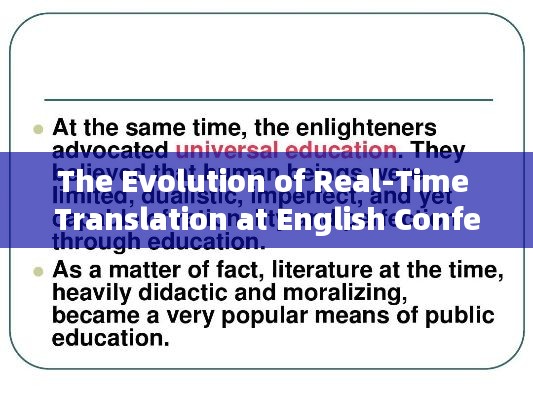The Evolution of Real-Time Translation at English Conferences
In the rapidly evolving landscape of global communication, the need for real-time translation at English conferences has become increasingly crucial. With the world becoming more interconnected, the ability to bridge language barriers and facilitate seamless communication among diverse groups of people has never been more important. This article explores the evolution of real-time translation at English conferences, highlighting the technological advancements, challenges, and future prospects of this vital service.
The Early Days: Manual Translation
The Early Days: Manual Translation
Before the advent of advanced technology, real-time translation at English conferences relied heavily on human interpreters. These skilled professionals would sit in a booth, listening to the speaker and simultaneously translating their words into another language. While this method was effective, it came with its own set of challenges. Interpreters could sometimes miss nuances in the speaker's tone or context, leading to potential misunderstandings. Additionally, the process was time-consuming and required a significant amount of training and expertise.
The Rise of Technology: From Consoles to Software
The Rise of Technology: From Consoles to Software
As technology advanced, so did the tools available for real-time translation. The introduction of dedicated translation consoles marked a significant shift in the industry. These consoles allowed interpreters to work more efficiently, with features like automatic speech recognition and simultaneous translation capabilities. However, the reliance on human interpreters remained, and the technology was still limited to specific events and locations.
Fast forward to the present day, and we see a surge in the development of software-based real-time translation solutions. These applications leverage artificial intelligence and machine learning algorithms to provide accurate and efficient translations. Software-based solutions are not only more accessible but also offer greater flexibility, allowing for real-time translation across various platforms and devices.
Challenges and Limitations
Challenges and Limitations
While technology has made significant strides in real-time translation, there are still challenges and limitations to overcome. One of the primary concerns is the accuracy of the translations. While AI-driven solutions have improved over the years, they are not yet perfect. Contextual understanding, cultural nuances, and idiomatic expressions can still pose difficulties for machines to interpret accurately.
Another challenge is the issue of latency. Real-time translation requires a fast and reliable internet connection to ensure that the translation is delivered promptly. In areas with poor connectivity, this can be a significant hindrance to the effectiveness of the service.
Additionally, the reliance on human interpreters is still prevalent, especially in high-stakes conferences where the stakes are high and the need for precise translation is paramount. The combination of human expertise and technological advancements is often seen as the ideal solution to bridge the gap between the two.
The Future of Real-Time Translation
The Future of Real-Time Translation
The future of real-time translation at English conferences looks promising, with ongoing advancements in technology and AI. Here are some key areas where we can expect to see improvements:
Enhanced Accuracy: As AI algorithms continue to evolve, the accuracy of real-time translations will likely improve, reducing the potential for misunderstandings.
Reduced Latency: With the development of faster and more reliable internet connections, the latency issue will be significantly reduced, ensuring a more seamless translation experience.
Increased Accessibility: As technology becomes more affordable and accessible, real-time translation services will become more widely available, breaking down language barriers for a broader audience.
Integration with Other Tools: Real-time translation services will likely integrate with other communication tools, such as video conferencing platforms, to provide a more comprehensive and user-friendly experience.
In conclusion, the evolution of real-time translation at English conferences has been a testament to the power of technology and its ability to bridge language barriers. While challenges remain, the future holds great promise for further advancements in this field, making global communication more accessible and effective for all.
Unlocking the Power of Real-Time Events: Engaging Audiences in the Moment
The Rise and Fall of Hot Products: Understanding the Ephemeral Trend in Consumer Goods
Navigating the English Language Trending Topics Chart: A Comprehensive Guide
The Evolution of English Popular Playlists: A Journey Through Time and Taste
The Future of Communication: Real-Time Translation on Company Sites
The Rise of Electric Vehicles: A Game-Changer in the Automotive Industry
The Latest Real-Time Policy Updates: A Comprehensive Overview













 蜀ICP备08106559号-1
蜀ICP备08106559号-1